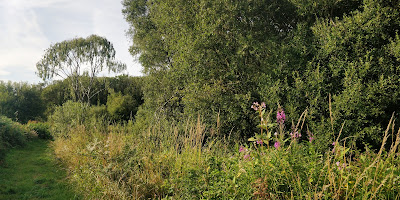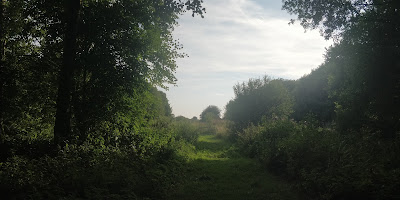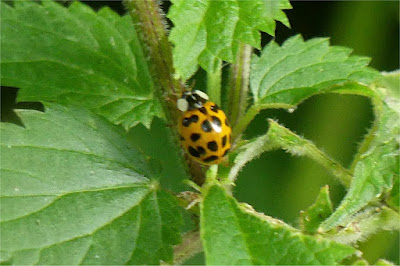 |
| Black-tailed godwits, black-headed gulls and avocets |
Another nice, not too warm yet, day so I got myself an old man's explorer ticket and headed up to Leighton Moss. The idea was to have a gentle toddle round the reserve but the lesser yellowlegs that was found on the Eric Morecambe pool last night was reported again this morning so I'd have a walk down to the coastal pools instead.
It was a quiet trip up on the train. I think I saw more large white butterflies than woodpigeons. Silverdale Station buzzed reassuringly, goldfinches and greenfinches sang in the trees while spadgers and blue tits fussed about in the old station house garden.
 |
| Slackwood Lane |
As I walked down Slackwood Lane blackcaps sang in the trees by the golf club and in the copse at the corner of The Row. I turned onto New Lane where swallows hawked low over the fields and road and a buzzard lazily drifted over the trees behind the farmstead. I negotiated the level crossing and Quicksand Pool Bridge, both places where the pedestrian needs to be wary of blind bends. A sedge warbler in the drain by the road took loud exception to me, even louder once the camera appeared and it disappeared into the depths of rank foliage.
 |
| From Quicksand Pool |
I walked down the path to Quicksand Pool and the car park, keeping an ear out for any cars driving down behind me. I thought I heard an incoming so I stepped off the path and looked back. The car I heard passed by and on into Warton. A large bird caught my eye as it floated over the reedbed behind the wall. At first I was seeing it head-on and thought it might be a buzzard but it didn't have light underparts and it was all wrong for a marsh harrier. The penny dropped as the bittern lowered its landing gear and disappeared into the reeds.
It was a pleasant walk down to the hides, a clear blue sky and enough breeze to keep it fresh. Greenfinches and goldfinches sang in the trees, chiffchaffs and robins flitted about, the wind blew the song of a skylark in from the marsh.
 |
| From the Eric Morecambe Hide |
I went straight to the Eric Morecambe Hide, which wasn't silly busy but all the windows along one side were occupied. I stood behind and had a scan round at the silhouettes on the pool. Lapwings… an oystercatcher… lots of redshanks… some dunlins feeding in the water with redshanks… a greenshank on an island with some redshanks… greylag geese… Way out in the distance a male marsh harrier drifted over a herd of mute swans on a far pool.
 |
| Redshanks, dunlins and lapwings |
One of the other birdwatchers breathed a loud sigh of relief: "Got it again! It's come out from behind that island but it's still a long way out." I listened as people found the lesser yellowlegs and lost it again, all the while trying to tell everyone else where to look. It sounds more chaotic than it actually is, there's something organic about the dynamic. I was being no bloody use at all until finally I picked up on the last landmark somebody had mentioned and saw the yellowlegs walking briskly past a redshank, giving me an opportunity to compare and contrast. Somebody beat me to the call. No matter, it isn't a competition. Lesser yellowlegs remind me very much of greenshanks although they're a bit smaller and darker. Compared to a redshank they look more lightly built and graceful, they're about the same size but look smaller. In a good light the legs would be a dead giveaway, in this light where the birds were largely silhouetted against the water it was a lot more difficult. Hard work but a nice bird.
 |
| The Allen pool |
I went over to the other side of the hide to look over the Allen pool. I'd heard the calls of black-headed gulls and the pipings of avocets and godwits on the way in. A few dozen black-tailed godwits, most of the adults in full fox red breeding finery and the juveniles in greys, roosted on the pool with a couple of dozen avocets. The sun was behind me so the lighting picked up the colours a treat.
 |
| Black-tailed godwits and avocets |
 |
| Black-headed gulls, black-tailed godwits and avocets |
 |
| Avocets |
As I was walking back one of the other birders offered me a lift back to Leighton Moss, which was good of him. He was off to Foulshaw Moss to see the ospreys. I thanked him and wished him luck with the ospreys and hoped he got a brace of tree pipits to go with them.
I had twenty minutes more than I'd bargained for for a nosy round. I was keeping an eye on the clock, I wanted to get the Manchester train and was feeling superstitious about it after just receiving the latest batch of Delay Repay travel vouchers (and there's more on the way). The feeders by The Hideout were busy with greenfinches, goldfinches and great tits with a gang of mallards gathering up the spillages.
 |
| Great crested grebes and coots |
The pool at Lilian's Hide was noisy with black-headed gulls and busy with coots and mallards. A few dabchicks dived about the reed edges. An eclipse drake pochard mingled with a crowd of eclipse drake mallards, only bringing attention to himself when he dived and bobbed back up again. The great crested grebes had a humbug in tow. Way over I could see one of the great black-back chicks flexing its wings ominously.
 |
| A great tit straight out of the bath |
I got back to the station with a couple of minutes to spare, stopping to a apologise to the pied wagtail I disturbed as I crossed the tracks to the Southbound platform. The heel was definitely pulling by this stage and became very uncomfortable as I travelled back. I think I'll need to do a long but gentle walk on the flat to ease some movement back in without pulling the tendon further. I'll see how it goes tomorrow.























































